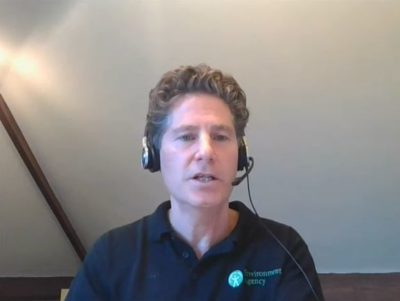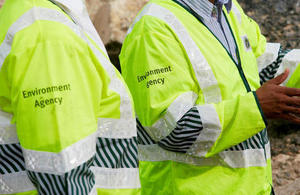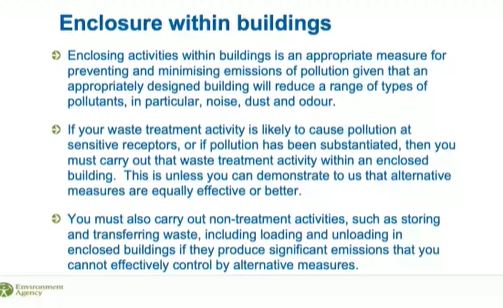The Environment Agency’s senior advisor for site-based regulation, Howard Leberman, has moved to clarify aspects of recently published proposed guidance for permitted facilities taking non-hazardous and inert waste.
Speaking at the National Civic Amenity Site (NCAS) Conference, Mr Leberman reiterated that the proposed regulations are not mandatory or definitive, but look to “frame the discussion and act as a starting point we will have with the operator”.
Published for consultation in September and ending last week, 18 November, the guidance had caused concern from some in the waste sector as it could see more waste operations having to take place in an “enclosed building” (see letsrecycle.com story).
It comes on the back of the development of the European waste management BREF which covers the installations of a number of hazardous and non-hazardous treatments.
Earlier this week, 24 November, UROC, the organisation for independent waste skip hire and transfer station operators, branded the proposals “unlawful”, and said the guidance in its current form would be a risk of a legal challenge by the way of judicial review.
Review
Mr Leberman began his talk at the NCAS conference by addressing concerns on the legality of the guidance.
He said his team received a lot of lobbying during the consultation, and some “very interesting headlines” appeared which he wanted to address, and hope to put some of the issues “to bed”.
Mr Leberman added: “One of the big headlines here is people saying we have got this completely wrong, it borders on illegal it is outside of our powers and we face judicial review.
“If we are going to face judicial review the first step will be the formal pre-action protocol letter which gives us a second chance to explore the legality of our guidance.
“I say a second chance become some of the issues have been duplicated in the consultation responses, and it’s the response document we will publish which will deal with these issues.
“If there is a formal letter, that is usually done after the response document and the guidance itself has been published. It will be interesting to see how all of this develops.”
Application
Mr Leberman explained that the guidance addresses appropriate measures for all waste activities, whether installations, storage or treatment.
He stated that it doesn’t mean that every facility will have to be enclosed, and explained that it is for the operator to “have regard to our guidance and make a compelling justification as to what is being done”.
He went on to say: “It depends on a variety of site specific circumstances as to when this guidance will apply. This is about the flexibility of the guidance, and it depends on what is being carried out, e.g a CA site vs an AD plant will be very different.
“It depends on size, location and type of operation and all of these site specific measures forms what mix of appropriate measures are right for the site.
“A lot of this is essentially a technical judgment about whether we agree with what the operator is telling us”
“Essentially, what the operator will do is say ‘well of the relevant requirements will be doing this but we won’t be doing that, and we won’t be doing that because we offer the same amount of protection through other measures we are implementing’.
“A lot of this is essentially a technical judgment about whether we agree with what the operator is telling us. And rightly so, it is a discussion and it is about good evidence to support an operator’s direction of travel”.
Staff
One criticism often levelled at this approach is that when a policy is in a guidance document like this, Environment Agency officers will often apply it to the letter when carrying out a site inspection.
However, Mr Leberman looked to ease these concerns, and said staff are well trained and are able to “tap into” a wealth of experience on the issue.
Addressing these concerns, he said: “The issue is whether our officer may have or may not have the confidence or experience to make the judgement. There is training, technical checks and support so if the officer needs help they can tap into it. They shouldn’t be making any of these judgments alone.
“If an operator believes what they’re being asked to do is not justified then the operator can challenge, and with those complex issues require support, either myself or my team will get involved in providing assistance or advice for that decision making process.”
He added that the guidance isn’t “fundamentally flawed just because it relies on individuals”.
Buildings
The aspect of the guidance which received the most criticism was on enclosed buildings for waste operations.
Mr Leberman referenced the below three points, and said some of the wording has already been changed in light of some of the comments which have been made.
“One of the things I’ve stripped out is when it says the building is a default, this was quite emotive and it got a response as we anticipated, but actually it distracts from the key message,” he said.
Mr Leberman continued: “The key message when talking about a building, one of many requirement were putting into the guidance as a starting point, is that we recognise that putting things in a building is an appropriate measure, of course it is. That building deals with a whole range of fugitive emissions when designed properly.
“What we’ve said is, if there is a risk, and it is a high risk, and a continual one, of an impact on the environment or your neighbours, then putting it in a building is appropriate.
“For CA sites we could argue that risk is low because of all the other measures you have in place to deal with his. We’re not asking for CA sites to be put into a building, although I noticed many others are. We’re saying if there is a risk, and you can not deal with that risk through alternative measures, that is the starting point. What we are not saying is ‘everything must be in a building’”.
Future
Looking forward, Mr Leberman explained that unless the body is derailed by Covid-19, unplanned Brexit complications or flooding, it intends to work through the consultation and publish a response document in the new year.
“We will use that thinking and learning and re-visit our guidance, and amended this accordingly before publication,” he said.
The body will also issue regulation 61 notices in the early new year, asking if sites can meet BAT. Operators will have 4-5 months to respond, he added.
The post Agency moves to clarify appropriate measures guidance appeared first on letsrecycle.com.
Source: letsrecycle.com Waste Managment





